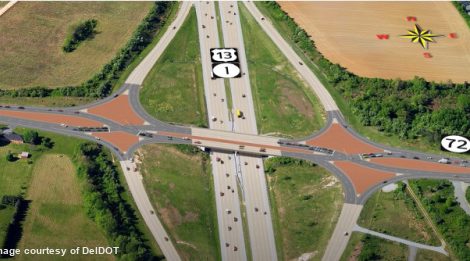Delaware Railroad Crossing Laws and Hazards
QUESTION: When is a TIE a GUARANTEED LOSS? See picture below.

THE LAW
TITLE 21
Motor Vehicles
Operation and Equipment
CHAPTER 41. RULES OF THE ROAD
Subchapter VII. Special Stops Required
§ 4161. Obedience to signal indicating approach of train, drawbridge or automatic signal system controlling the flow of traffic.
(a) Whenever any person driving a vehicle approaches a railroad grade crossing, drawbridge or automatic signal system controlling the flow of traffic under any of the circumstances stated in this section, the driver of such vehicle shall stop within 50 feet but not less than 15 feet from the nearest rail of such railroad, and shall not proceed until the driver can do so safely.
Evidently the STOP LINE in the picture below is a minimum of 15 feet from the nearest rail. So according to Delaware Law, the legal stopping point would be at the STOP LINE.

QUESTION: If the overhead lights are flashing red and it is a slow moving train, can it be legal to cross the track after stopping?
ANSWER: YES? “…and shall not proceed until the driver can do so safely.” WE REPORT – YOU DECIDE!
Immediately below you will find some suggestions from the Delaware Drivers Manual – pages #80 & #81.
Rail Intersection Signs And Signals
1. Railroad crossings have signs or signals to warn drivers.
2. Never try to beat a train across the tracks.
3. Never start to cross if there is not room for your vehicle on the far side, or if you will have to stop on the tracks.
4. DO NOT BLOCK THE CROSSING. Wait until there is room for your vehicle on the far side.
5. It is wise not to shift gears when crossing railroad tracks, just in case you might stall.
6. It would also be wise to review “Stalling On Railroad Tracks” under Emergencies in Section Five.
7. Remember that trains are large and may be moving faster than they look.
8. Many highway-rail intersections have roadway surface or pavement markings in advance of the crossing. These markings usually include an “X”symbol with the letters “RR” and a stop bar.
9. A white, X-shaped sign or “crossbuck” with Railroad Crossing on it is located at the railroad crossing. This sign has the same meaning as a Yield sign. You must yield to crossing trains.
10. At some crossings, along with the crossbuck sign, you will see side-by-side lights that will flash when a train is approaching. When the lights are flashing, you must stop.
11. At some crossings there is also a crossing gate that will lower when a train is coming. Do not drive around the gate.
12. Some crossings also have a bell that will sound. Do not cross until the bell has stopped.
13. Crossings with more than one train track often will post a sign that shows the number of tracks. These signs warn you that there is more than one track and there may be more than one train crossing.
14. If you come to a railroad crossing without a number-of-tracks sign, it is important that you always check if there is more than one track before crossing.






